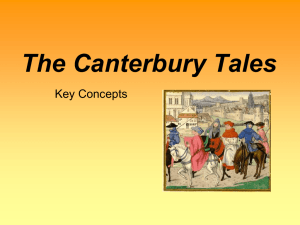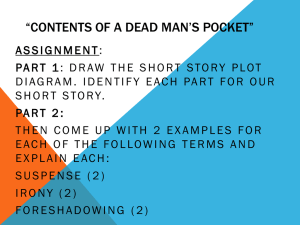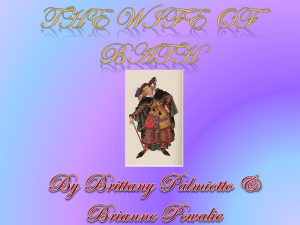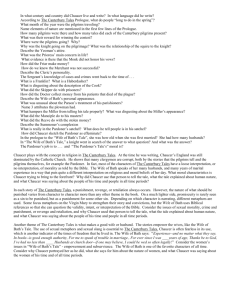Irony in Wife of Bath
advertisement
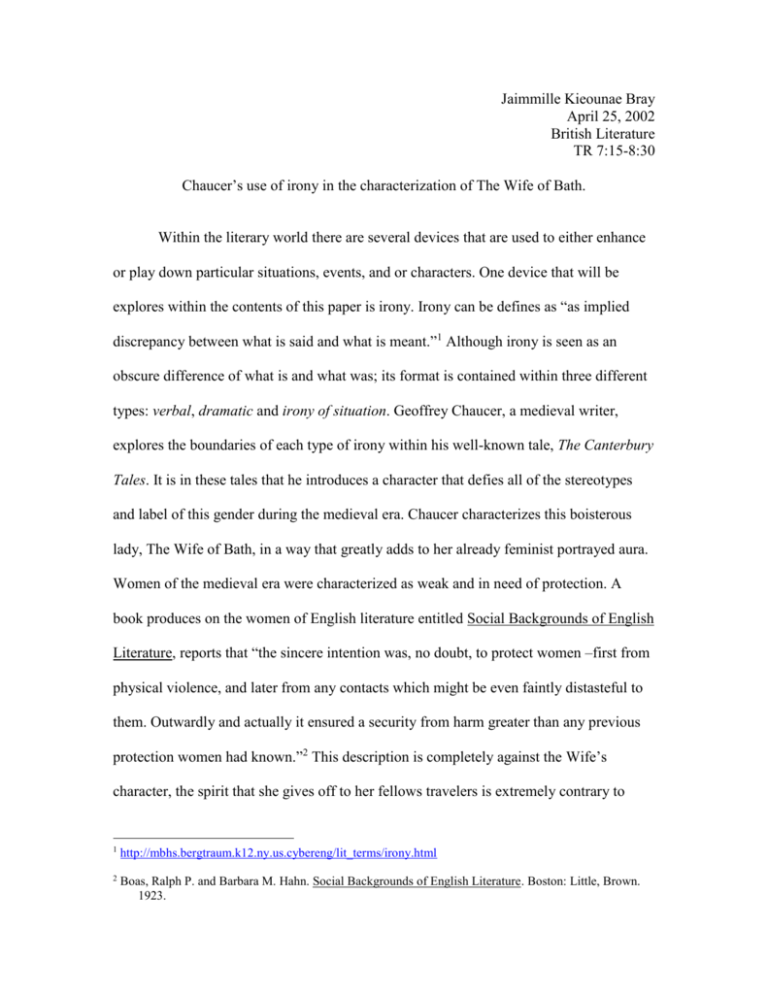
Jaimmille Kieounae Bray April 25, 2002 British Literature TR 7:15-8:30 Chaucer’s use of irony in the characterization of The Wife of Bath. Within the literary world there are several devices that are used to either enhance or play down particular situations, events, and or characters. One device that will be explores within the contents of this paper is irony. Irony can be defines as “as implied discrepancy between what is said and what is meant.”1 Although irony is seen as an obscure difference of what is and what was; its format is contained within three different types: verbal, dramatic and irony of situation. Geoffrey Chaucer, a medieval writer, explores the boundaries of each type of irony within his well-known tale, The Canterbury Tales. It is in these tales that he introduces a character that defies all of the stereotypes and label of this gender during the medieval era. Chaucer characterizes this boisterous lady, The Wife of Bath, in a way that greatly adds to her already feminist portrayed aura. Women of the medieval era were characterized as weak and in need of protection. A book produces on the women of English literature entitled Social Backgrounds of English Literature, reports that “the sincere intention was, no doubt, to protect women –first from physical violence, and later from any contacts which might be even faintly distasteful to them. Outwardly and actually it ensured a security from harm greater than any previous protection women had known.”2 This description is completely against the Wife’s character, the spirit that she gives off to her fellows travelers is extremely contrary to 1 http://mbhs.bergtraum.k12.ny.us.cybereng/lit_terms/irony.html 2 Boas, Ralph P. and Barbara M. Hahn. Social Backgrounds of English Literature. Boston: Little, Brown. 1923. whom this lady actually is. Because Chaucer allows The Wife of Bath to contradict herself throughout her prologue and tale, it makes her potentially an interesting character to those who read her story. Verbal irony, “when an author says one thing and means something else”3, is omnipresent throughout the Wife’s account. Practically every word that is uttered from her lips is deviating from her true nature and character. This deviance however, makes her account one that is full of intrigue, and laughter. While there are several examples of this type of irony in her tale, the first obvious illustration would be the feminist voice that is put out by Chaucer for her. By feminist it is meant that both men and women are equal. Chaucer’s character puts out the radical feministic approach. This term is defined as women that object to the oppression that is placed upon them by society and males. This voice that she speaks in is extremely convincing to her fellow travelers, but not to those who read her words. Chaucer uses the literary device known as aside, where the reader can know the woman’s true thoughts and feelings on the subject she speaks of. This type of device concretely demonstrates her enormous of contradicting utterances that stem from her voice. The Wife of Bath allows feminist ideas to come out of her mouth. Within these statements are attitude, anger, domination, and other suppressive statements. As modern as her statements are, she really has the nature of women in opposition of her character. While she speaks of total domination over each her husbands, in truth she wants to be dominated and submissive to them and only them. She only wants what most women want from men in their life…love. This notion is no more prevalent than in her speech about her last husband. In her prologue she states, 3 http://mbhs.bergtraum.k12.ny.us.cybereng/lit_terms/irony.html “And yit he was to methe moste shrewe: That feele I on my ribbes al by rewe, And evere shal unto myn ending day. But in oure bed he was so fresh and gay … He coude winne again my love anoon. I trowe I loved him best for that he Was of his love daungerous to me”4 She tales of how he would beat her and dominate her throughout their relationship. Through all of that she proclaims loudly and strongly that she loved him best of all. While this antifeminist woman constantly voices feminist statements and attitudes, another intriguing example of how Chaucer enhances her character lies in her justification of loose sexual practices by God and saints of the Bible. The Wife utilizes false pretense’s to right her wrong. Relying on the Good Samaritan, Solomon, and Gods laws pertaining to marriage and consummation to plead her case to her listeners. “Lo, here the wise king daun Saloman: I trowe he hadde wives many oon, As wolde God it leveful were to me To be refreshed half so ofte as he.”5 Abrams, M.H. Ed. “The Norton Anthology of English Literature” The Cantebury Tales. Geoffrey Chaucer. New York: W.W. Norton & Company, 2001. 5 Abrams, M.H. Ed. “The Norton Anthology of English Literature” The Cantebury Tales. Geoffrey Chaucer. New York: W.W. Norton & Company, 2001. 4 Here Chaucer allows his character to expose and twist the contents of a sacred book to tailor her sinful, lustful ways. How ironic is this? When has God ever “permitted” sex out of marriage and not for marriage laws and aspects? Another example that she states is that “ God bad us for to wexe and multiplye.” In both of these examples, the reader pf the tale is possibly perplexed at such potentially outrageous comments. This notion of God condoning such an act is in itself ironic, that fact she states this makes it verbally ironic. Other Biblical references are made towards Abraham and Jacob. Chaucer permits his character to take something sacred and pure and turn it disgrace, dirty, and unholy. While these outrageous illustrations of the verbal irony stemming from the Wife, other ones are to follow. “When an audience perceives something that a character in the literature does not know”6, is the definition of dramatic irony. Particularly, it is this form that defines the amazement of the Wife if Bath’s character. Chaucer uses this form to provide the hard and rigid backbone of her tale. Chaucer permits her to expose herself as a strong, dominant woman to the travelers riding along with her. To the audience the mask is taken off. The mask of feminism is trashed revealing a lady who only wanted each of her husbands to love her. If one was a psychologist, the remarks made about controlling the men, can be seen as a cry of help by her. The effect of placing her internal thought along with her actual words, allows the reader to see that despite what comes from her mouth, she only wants to love and to be loved. This method enhances the drama of her tale, thus making her contradictions interesting and dramatically ironic. From the onset of her story Chaucer’s character exemplifies complete domination of men. She wants to control their minds, money, and sexual nature. The references she 6 <http://mbhs.bergtraum.k12.ny.us/cybereng/lit_terms/irony. html > makes in the midst of her storytelling each contain the above fore mention topics, from the Biblical alludements to the knight and his queen. No matter what she speaks of, it is tainted with traces absolutism and not democracy or equality. As she continues along in the journey, her tone changes. There are hints of movements in her thoughts in how she describes each husband concluding with the fifth. Also, by the times the knight finds the answer to the queen’s request, the Wife has placed herself within her story. This lady that finds her mate submits to her equally as he submits to her, and they fall in love and live ever after. “My lady and my love, and wif so dere, I outte me in youre wise governaunce: Cheseth yourself which may be most plesaunce And most honour to you and me also.”7 The main purpose of the Wife’s numerous marriages was to find and receive what the character in her tales has-equal love. Her character has no trouble submitting to her husband, and the husband has no problem submitting to his wife. This character that she speaks of is actually she. Chaucer’s usage of this method of internal characterizations within a story is precisely what makes the irony prevalent to his readers. The final form of irony that is knowledgeable in The Canterbury Tales, is situational irony. In this form what is expected and what actually happens is contradicted. There are two illustrations of this kind in Wife of Bath’s tale. The most interesting illustration is in the fifth husband. As she speaks of him, she tells of how he would read 7 Abrams, M.H. Ed. “The Norton Anthology of English Literature” The Cantebury Tales. Geoffrey Chaucer. New York: W.W. Norton & Company, 2001. to her about women that dominated their men and controlled everything that the men had. This it self was ironic. Here you have a woman that wants to dominate and has dominated men in her past, now being exposed by a man that she is attempting to dominate. One by one he listed women that were the “blame” for the downfall of particular men. “Of Eva fist, that fo hir wikkednesse Was al mankinde brought to wrecchedenesse, … Of Clytermistra for hir lecherye That falsy made hr housbonde for to die, He reede it with ful devocion.”8 This husband literally contradicted everything that his wife was trying to do and become. Because Chaucer expressed this scene in the tale, the reader is able to view how his characters’ mind works. This inside view that is hidden from the people in the text permits the readers to have a “heads up” on her thinking. An additional case of irony in the Wife’s tale lies in how she establishes a teacher role from the onset of her narration. She employs the minds of her fellow travelers by informing them that she will “school: them on how to love and control your mate. As she continues in her efforts of instruction, she in return becomes the student. From her tales about Biblical men, to the lady and her knight, the Wife learns about total submission and humbleness. Each of her five husbands has taught her something about herself and her 8 Abrams, M.H. Ed. “The Norton Anthology of English Literature” The Cantebury Tales. Geoffrey Chaucer. New York: W.W. Norton & Company, 2001. character. Particularly the fifth husband boldly makes her realize her own imperfections and crimes. This tale by the Wife is one full of irony. The statements that are uttered from her lips are always against who she really is and what she actually believes. Chaucer placed each type of irony: verbal, dramatic, and situational within the contents of her speech to enhance the readers’ perception of her. By doing this, the readers are able to view his characters real person. These types of irony enable the Wife of Bath to play down the stereotypes that are placed upon her and other females of the era. Chaucer was perhaps intentionally using this method of writing to make his character that extra “something” that sets her and her tale aside from all of the others. This tale by the Wife is perhaps the most well-known and discussed tale from the book. Due to her comparisons and speeches, she has possibly intrigued her readers for along time.
